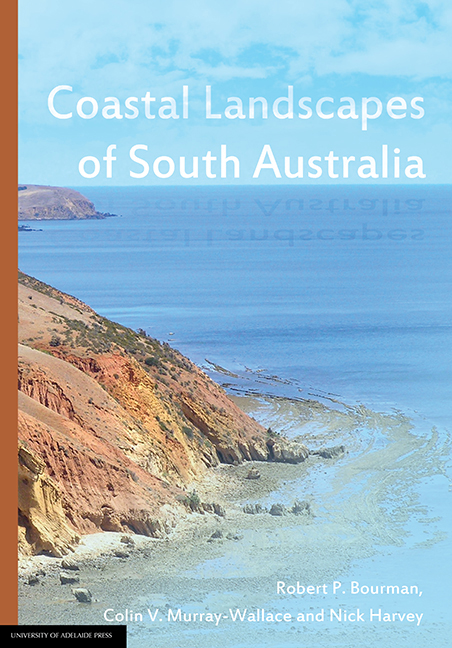Book contents
- Frontmatter
- Dedication
- Contents
- Preface
- Biographies
- Acknowledgements
- 1 Coastal landscapes of South Australia
- 2 The coast of metropolitan Adelaide
- 3 The Fleurieu Peninsula coast
- 4 The River Murray Estuary
- 5 The Coorong Coastal Plain and the Limestone Coast
- 6 The northern Gulf St Vincent tidal coastline (the Samphire Coast)
- 7 The Yorke Peninsula coastline
- 8 The northern Spencer Gulf coast
- 9 The Gulf Coast of Eyre Peninsula
- 10 The Bight Coast - West coast of Eyre Peninsula
- 11 Kangaroo Island
- 12 Explaining the coastal landscapes of South Australia - A synthesis
6 - The northern Gulf St Vincent tidal coastline (the Samphire Coast)
Published online by Cambridge University Press: 25 July 2017
- Frontmatter
- Dedication
- Contents
- Preface
- Biographies
- Acknowledgements
- 1 Coastal landscapes of South Australia
- 2 The coast of metropolitan Adelaide
- 3 The Fleurieu Peninsula coast
- 4 The River Murray Estuary
- 5 The Coorong Coastal Plain and the Limestone Coast
- 6 The northern Gulf St Vincent tidal coastline (the Samphire Coast)
- 7 The Yorke Peninsula coastline
- 8 The northern Spencer Gulf coast
- 9 The Gulf Coast of Eyre Peninsula
- 10 The Bight Coast - West coast of Eyre Peninsula
- 11 Kangaroo Island
- 12 Explaining the coastal landscapes of South Australia - A synthesis
Summary
Introduction
The northern coastline of Gulf St Vincent (GSV) is a low-energy environment dominated by wide tidal flats with a peritidal sequence of subtidal seagrass meadows, intertidal sandflats and mangroves, and supratidal saline marshland. The broad form of the coast reflects the dominance of intertidal processes and their interrelationships with peritidal fauna and flora. Seagrasses thrive in the subtidal and intertidal shallow warm waters, with extremely productive calcareous algae, foraminifers and molluscan organisms manufacturing vast amounts of calcareous sediment. The accumulation of these biogenically derived sediments has generated the resultant wide intertidal and supratidal flats visible today by causing the shoreline to aggrade (build up) and prograde (build seawards).
Most of the northern GSV coast is bordered by mangroves (Figure 6.1), which occur from the Port River Estuary on the eastern side of the gulf around to Price on the northwestern side of the gulf. The mangrove woodlands are quite extensive around Barker Inlet, Middle Beach and the Light River delta on the eastern side of the gulf, at the northernmost part of GSV north of Sandy Point, Port Wakefield and continuing through the head of GSV to its western side around Port Clinton, Mangrove Point and Price. In the Barker Inlet, Caton et al. estimated that over 900 hectares (ha) is remnant vegetation, most of which is mangrove.
An extensive area of the northern GSV mangroves occurs within the Clinton and Wills Creek Conservation Parks. The Clinton Conservation Park (1923 ha) is a boomerang-shaped reserve extending from Sandy Point through Port Wakefield and around the western side and head of the gulf, to just north of the township of Port Clinton. The Wills Creek Conservation Park (2130 ha) is situated at Mangrove Point on the northwestern shores of GSV and extends from Port Clinton south to the town of Price.
An equally dominant feature of the northern GSV coastline is the extensive salt marsh environment occupying the intertidal to supratidal areas resulting in the GSV coast being referred to locally as ‘the Samphire Coast’. This type of coast is particularly important for its conservation significance, given the loss of large areas of similar salt marsh environment on the metropolitan coast. Within the Gulf, it is estimated that there are 6000 ha of salt marsh on the eastern side, 2000 ha at the head of the gulf and around 4700 ha on the western GSV coast.
- Type
- Chapter
- Information
- Coastal Landscapes of South Australia , pp. 177 - 196Publisher: The University of Adelaide PressPrint publication year: 2016



